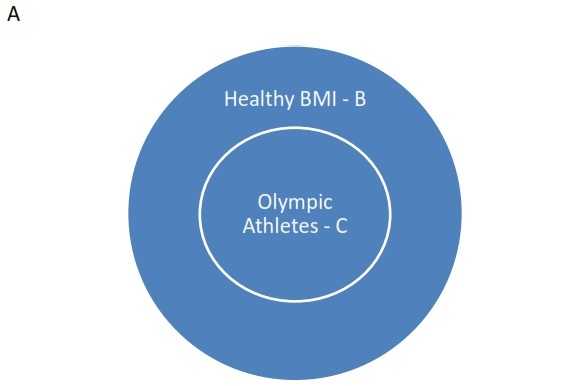
Confusing between subsets and supersets on GMAT Critical Reasoning
Confusing between Subsets and Supersetson CR
In GMAT critical reasoning, there are several different types of questions that you will encounter. In this short article, we will cover the characteristics of questions wherein the trap involves confusion between subsets and supersets.
Confusion between Subsets and Supersets
This error is said to occur when a “subset” is confused with its “superset”.
Please take a look at the following example to better understand this concept.
Example 1:
All Olympic athletes maintain a healthy body mass index.
Which all of the following must be true?
- Anybody who maintains a healthy body mass index is an Olympian athlete.
- Only Olympic Athletes maintain a healthy body mass index.
- Anybody who does maintain a healthy body mass index is not an Olympic athlete.
- If Jack is an Olympic athlete, Jack maintains a healthy body mass index.
- If Lily is not an Olympic athlete, she does not maintain a healthy body mass index.
- Ida does not maintain a healthy body mass index; Ida is not an Olympic athlete.
Here, we have a statements followed by a question stem and a bunch of other statements. Before reading further, please go through the statements and put a cross or check mark, depending on whether you believe the statement
must be true.

Here, we have the set of “Olympic Athletes”, which is a subset of “People with Healthy BMI”. Thus, we can also say that “People with Healthy BMI” is a superset of “Olympic Athletes”. So, area A represents the set of people who do not maintain a healthy BMI and are thus, also, not Olympic athletes. Area B represents the set of people who maintain a healthy BMI but are not Olympic athletes. Area C represents the set of people who are Olympic athletes and, thus, maintain a healthy BMI. With this groundwork done, let us now take a look at the statements.
1.
Anybody who maintains a healthy body mass index is an Olympian athlete.This statement refers to areas B and C; this cannot be said, as B is the subset of people who maintain healthy body mass index but are not Olympic athletes. This is not a must be true statement.
2.
Only Olympic Athletes maintain a healthy body mass index. Once again, this cannot be said, as B is the subset of people who maintain healthy body mass index but are not Olympic athletes. This is not a must be true statement.
3.
Anybody who does maintain a healthy body mass index is not an Olympic athlete.This refers to areas A and C; this statement is correct, as A and C are mutually exclusive; “Olympic Athletes” is a subset of “People with Healthy BMI”, so everyone who is an Olympic athlete maintain a healthy BMI. This is a must be true statement.
4.
If Jack is an Olympic athlete, Jack maintains a healthy body mass index.This statement implies that “Jack” belongs to area C, the subset “Olympic Athletes”. Since “Olympic Athletes” is a subset of “People with Healthy BMI”, “Jack” must belong to the superset “People with Healthy BMI”. This is a must be true statement.
5.
If Lily is not an Olympic athlete, she does not maintain a healthy body mass index.This statement implies that “Lily” belongs to either area A or area B; if “Lily” belongs to area A, she does not maintain a healthy body mass index, but if she belongs to area B, she does. So, this statement can be true or false. This is not a must be true statement.
6.
Ida does not maintain a healthy body mass index; Ida is not an Olympic athlete.This statement implies that “Ida” belongs to area A. If “Ida” belongs to A, she cannot belong to area C, as the two are mutually exclusive; thus, she cannot be an Olympic athlete. This is not a must be true statement.
This article has deliberately been kept brief; for a more elaborate explanation, please refer to the Experts’ Global Stage One Critical Reasoning videos.
